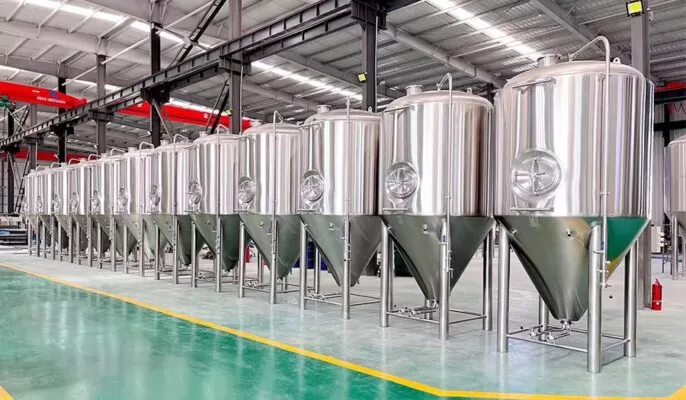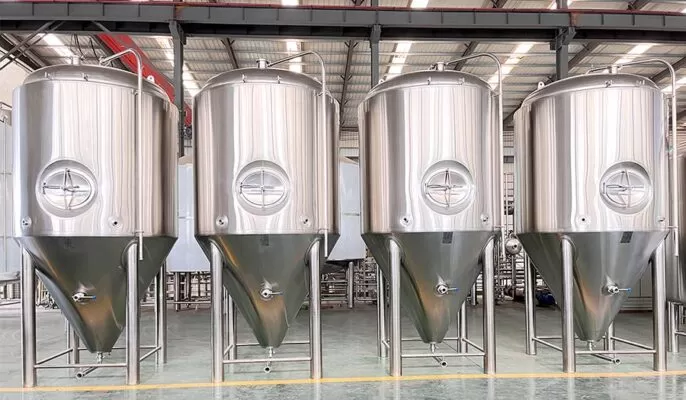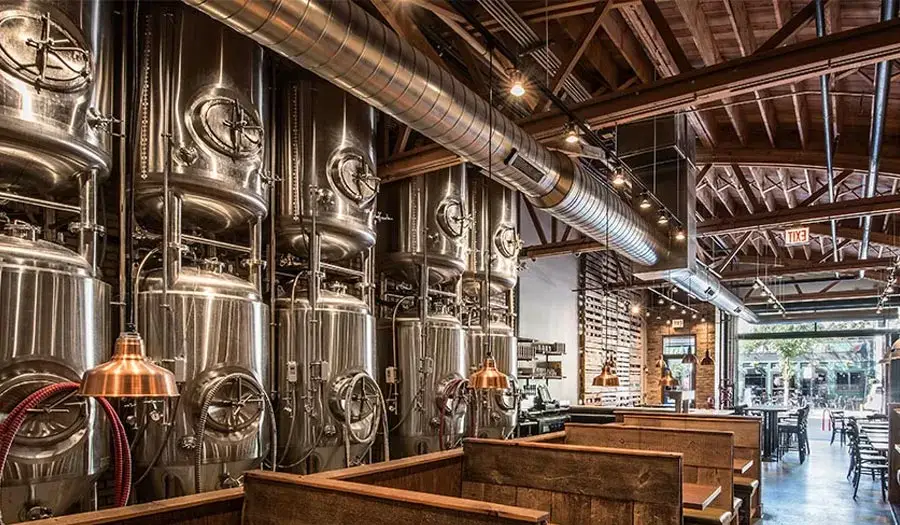Fermenters are available in a variety of sizes and formats to suit the needs of the brewer. Size is the main factor to consider when purchasing a fermenter. During the entire fermentation process, also to the wort, a thick layer of foam is formed, called Clausen foam. If your fermenter is too small, the foam will increase through the airlock, clogging the airlock and causing a blowout. The fermenter must be at least twenty percent larger than the amount of beer you intend to brew. Once you determine the size of the fermenter you need, you can decide on the most suitable style and material. Each type of fermenter has its advantages and disadvantages, but, your decision depends on budget and personal preference.
발효기의 종류
There are three main types of fermentation tanks, let’s take a look at them.
개방형 상부 발효 탱크
오픈탑 발효기는 뚜껑이나 밀봉이 없는 단순한 용기로 가장 기본적인 유형의 발효기입니다. 캡(발효 중에 표면으로 올라오는 포도 껍질과 씨앗의 층)에 쉽게 접근하고 수동으로 누를 수 있기 때문에 와인을 발효하는 데 사용됩니다.
폐쇄형 발효조
폐쇄형 발효기에는 외부 오염물질이 발효 과정에 유입되는 것을 방지하는 밀봉된 뚜껑이 있습니다. 이는 액체가 공기에 노출되어 부패하거나 맛이 나빠지는 것을 방지하기 때문에 맥주 양조에 사용됩니다.
Variable capacity 발효 탱크
가변 용량 발효기는 떠 있는 뚜껑과 조절 가능한 용량을 갖추고 있어 다양한 양의 액체를 발효하는 데 적합합니다. 유연성을 제공하고 발효액과의 공기 접촉량을 줄이는 데 도움이 되기 때문에 가정 양조업자와 소규모 양조업자에게 인기가 있습니다.

What size primary fermenter is required?
In the early stages of fermentation, a thick layer of foam will form on top of the wort, called clausen. Clausen helps protect the fermenting wort from infection and is a good indicator of how things are going. As fermentation ends, the amount of Clausen decreases.
If you were to fill a fermentation vessel with wort, Clausen would have nowhere to go and would be forced through an airlock that might be clogged. The pressure in the fermenter then increases until the airlock is blown out.
To stop this from happening, you should choose a fermenter that is 20% larger than the volume of beer you want to brew. This leaves a space at the top of the fermenter, called headspace.
Most homebrew recipes are designed to produce five-gallon batches of beer and must a six-gallon or six-and-a-half-gallon fermenter.
What size fermenter is needed for secondary fermentation?
Once fermentation is complete, you can bottle or barrel the beer, or transfer it to a second container for aging. speaking, secondary fermenter is a misnomer because almost no fermentation occurs. More hops, spices and other ingredients can also be added at this stage.
Unlike primary fermenters, primary fermenters must more headspace for Clausen formation. The secondary fermenter should be as full as possible. This minimizes the amount of air exposure and reduces the chance of oxidation and unwanted off-flavors in the beer.
What size more fermenter is needed?
The beer can be bottled or kegged, or it can be transferred to a second container for aging after fermentation is complete. The second fermenter must be as complete as possible. This reduces the amount of air exposed and the chance of the beer oxidizing and developing undesirable off-flavors. For the 5-gallon kit, you will need a 5-gallon secondary fermenter.
Fermentation tank material selection
Plastic buckets and basins
Many homebrewers use food-grade plastic buckets as their fermentation tanks. Plastic kegs are cheap, lightweight, easy to store, and can be purchased with air locks and spigots for bottling finished beer. transfer wort from pot to fermenter. Fermentation barrels are available in a variety of sizes, from 5 liters (1 gallon) to 30 liters (8 gallons). Or you can buy a food grade container and add an airlock and tap it yourself.
The disadvantage is that the lid is not sealed and oxygen can enter.

Glass bottle
Glass bottles have long been the go-to choice for home brewing and winemaking. Glass jugs and vials come in a wider range of sizes, from half-gallon (three-liter) jars to 15-gallon (54-liter) vials. The glass is wear-resistant and will not scratch. It is also 100% oxygen impermeable and does not absorb taste or odor.
Unlike buckets, small and large bottles are heavy and difficult to store because they cannot be stacked. They also usually don’t have taps, which means you have to use a siphon or rack rod to transfer your beer.
스테인리스 스틸 발효 탱크
Stainless steel fermenters offer all the benefits of plastic fermenters but are scratch-proof, impermeable and very easy to clean. If you have the budget, Micet suppliers sell stainless steel fermentation tanks in various sizes. If you’ve ever visited a commercial brewery, you’ll notice that fermentation takes place in tall stainless steel vats that taper toward the bottom.
Conical fermenters allow breweries to remove dregs from the beer without pouring it into a second container. This means that primary and secondary fermentations can take place in the same barrel without putting the beer at risk of contamination. Conical fermenters also make it easy to harvest yeast, which can then be cleaned and reused.
How to choose the right fermenter for your needs
When selecting a fermentation tank, the following factors should be considered:
- The type of beverage or food you plan to ferment
- 귀하의 경험 수준과 기술
- Available space in brewing or fermentation area
- 귀하의 예산
- 필요한 발효기 용량





나는 당신이 바로 여기서 할 수 있는 것보다 훨씬 더 사랑했습니다. 그림도 좋고, 글도 스타일리시한데, 너무 서두르시는 것 같아서 조만간 다시 드려야 할 것 같아요. 당신이 이 산책을 보호한다면 나는 아마 계속해서 그런 일을 할 것입니다.